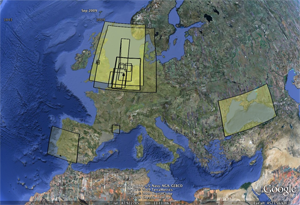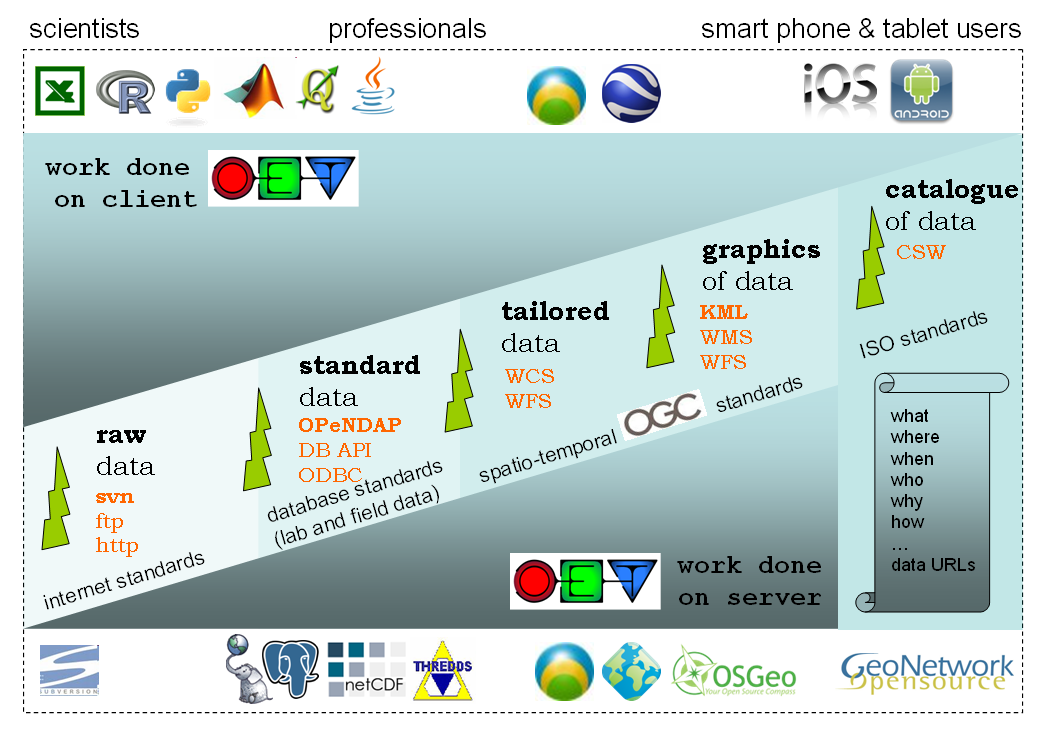 The OpenEarth philosophy related to data involves that important data sets, rather than working on a project-by-project basis, should be collected and be made available in a project-superseding manner. intends all datasets to conform with a number of basic quality criteria:
The OpenEarth philosophy related to data involves that important data sets, rather than working on a project-by-project basis, should be collected and be made available in a project-superseding manner. intends all datasets to conform with a number of basic quality criteria:
- data is not just numbers and meta-information, but consists of raw data produced by the measuring equipment (e.g. volts) + processing scripts.
- raw data should be stored in the OpenEarthRawData repository enabling version control
- raw data should then be enriched with metadata and processed into useful data products (netCDF) using transformation scripts also put under version control in a repository
- resulting data products should conform to the best open source standards available
- data products should be made available easily via webbased interfaces but also with automated procedures for widely-used data processing languages (matlab, IDL, python, fortran, C, java)
- data products are primarily meant for dissemination, raw data and scripts are primarily meant for archiving.
To achieve this international standards are embraced like:
- netCDF (self-describing, open source, widely-used file-format standard)
- CF parameter meta-data (vocabulary of quantities)
- Unidata units (vocabulary of units)
- EPSG
 spatial meta-data codes
spatial meta-data codes (vocabulary of coordinates)
(vocabulary of coordinates) - INSPIRE owner meta-data

- Open source Creative Commons philosophy
 or GNU
or GNU
- OPeNDAP
 (as running operationally for MATROOS
(as running operationally for MATROOS )
) - OpenGIS

- Fabric For loading data on the opendap server you can use fabric.
The data collection procedure and the relation between those standards is explained in the [OpenEarth Data Standards] document, developed in the framework of the EU FP7 Project MICORE. Currently data sets are being uploaded to the OPeNDAP production servers![]() THREDDS
THREDDS![]() (default) and HYRAX
(default) and HYRAX![]() (incl. kml previews for Google Earth/maps, but *.nc access not yet fully operational) and to the OPeNDAP test server
(incl. kml previews for Google Earth/maps, but *.nc access not yet fully operational) and to the OPeNDAP test server![]() THREDDS
THREDDS![]() . Examples from open datasets from the internet on OpenEarth include:
. Examples from open datasets from the internet on OpenEarth include:
- Rijkswaterstaat
 JarKus
JarKus and vaklodingen
and vaklodingen coastal bathymetry data (web source
coastal bathymetry data (web source ).
). - Rijkswaterstaat
 coastal grain size fields
coastal grain size fields .
. - Rijkswaterstaat
 sediment atlas Wadden Sea
sediment atlas Wadden Sea (web source
(web source ).
). - Rijkswaterstaat
 DONAR database subset from www.waterbase.nl (water levels, salinity, temperature, SPM, chlorofyll)
DONAR database subset from www.waterbase.nl (water levels, salinity, temperature, SPM, chlorofyll) (web source
(web source ).
). - KNMI
 potential wind
potential wind time series (web source
time series (web source ).
). - KNMI
 daily averaged meteo
daily averaged meteo time series (web source
time series (web source ).
). - TNO
 / AHN
/ AHN digital elevation map of the Netherlands
digital elevation map of the Netherlands .
. - Deltares / Rijkswaterstaat Delta flume experiments
 .
.

Numerous other datasets have been or are being uploaded continually in the MICORE and Building with Nature research programmes.
OpenEarth is not the only initiative to share and disseminate government-paid Earth science data freely on the web using open standards. We made an inventory of related initiatives.
<object width="425" height="344"><param name="movie" value="http://www.youtube.com/v/7w2DBazX6g4&hl=en&fs=1"></param><param name="allowFullScreen" value="true"></param><param name="allowscriptaccess" value="always"></param><embed src="http://www.youtube.com/v/7w2DBazX6g4&hl=en&fs=1" type="application/x-shockwave-flash" allowscriptaccess="always" allowfullscreen="true" width="425" height="344"></embed></object>
<object width="425" height="344"><param name="movie" value="http://www.youtube.com/v/7w2DBazX6g4&hl=en&fs=1"></param><param name="allowFullScreen" value="true"></param><param name="allowscriptaccess" value="always"></param><embed src="http://www.youtube.com/v/7w2DBazX6g4&hl=en&fs=1" type="application/x-shockwave-flash" allowscriptaccess="always" allowfullscreen="true" width="425" height="344"></embed></object>
| Unknown macro: {lozenge} Visualisation in Google Earth |
| Unknown macro: {lozenge} data visualisations in Google Earth |
| Unknown macro: {lozenge} Store your raw data here |
| Unknown macro: {lozenge} OpenEarth data collection protocol |
| Unknown macro: {lozenge} OpenEarth Tutorials |
| Unknown macro: {lozenge} Access using OpenDAP protocol THREDDS only |
| Unknown macro: {lozenge} Access data using the WMS and WFS services |